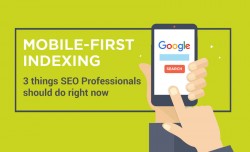Mobile-first indexing in 2018: 3 things SEO Professionals must do right now !

Being an SEO expert or a firm, your main objective is to bring more traffic and business to your clientele base and helping them in their overall growth. While the efforts and techniques remain the same while doing the optimization of their Web sites, the sudden change in Google algorithms can certainly spoil all your efforts and change the whole game in no time. To be more precise, the recent update by Google webmaster quotes:
“To make our results more useful, we’ve begun experiments to make our index mobile-first. Although our search index will continue to be a single index of websites and apps, our algorithms will eventually primarily use the mobile version of a site’s content to rank pages from that site, to understand structured data, and to show snippets from those pages in our results. Of course, while our index will be built from mobile documents, we’re going to continue to build a great search experience for all users, whether they come from mobile or desktop devices.”
This more or less confirms the fact that if your website isn’t Mobile friendly or isn’t optimized for the mobile version, there is less chance that it will be ranked higher on either Mobile or desktop devices. While a definite time period hasn’t been announced yet for implementing this mobile-first index thing, a lot has been said about its implementation happening early this year. At SMX Advanced last June, Google’s Gary Illyes has signaled 2018 as the likely deployment year for the mobile-first index. So with the new update around the corner, you must be ready for the same sooner than later and must do these following three things to help your client’s website and their business:

Your website design must be responsive
Responsive sites not only offer a perfectly optimized browsing experience, they ultimately provide a double advantage to the end user as the website can be perfectly experienced in both Mobile and web versions. You must include these basics in a responsive design which includes:
- Fluid site grid with proportionate measures
- Flexible texts and images
- Changes in design to ensure better user experience for non-desktop devices
- Using CSS media queries to define breakpoints for design changes.
Hire or invest in a mobile-optimized website builder
A mobile optimized website builder will make your website Mobile responsive: i.e., it detects what your visitor is using (a smartphone or a tablet) and automatically adjusts the layout of your website to fit the size of the gadget being used. A better and fast website would ensure more sessions online, more customer conversions, lower bounce rate, and higher engagement.
Content which is Optimized for Mobile
Though most of the visitors through mobile don’t spend that much time online for a website if your content is interesting enough and Mobile friendly, chances are high that it will get more visits by the end users. You can also undergo following tips for your use.
- Encourage engagement beyond your website by using mobile applications.
- Maintain and develop High-Quality content
- Use GIF, infographics, Meme’s, articles, high-quality images, videos.
- Use shorter headlines to Increase User experience





